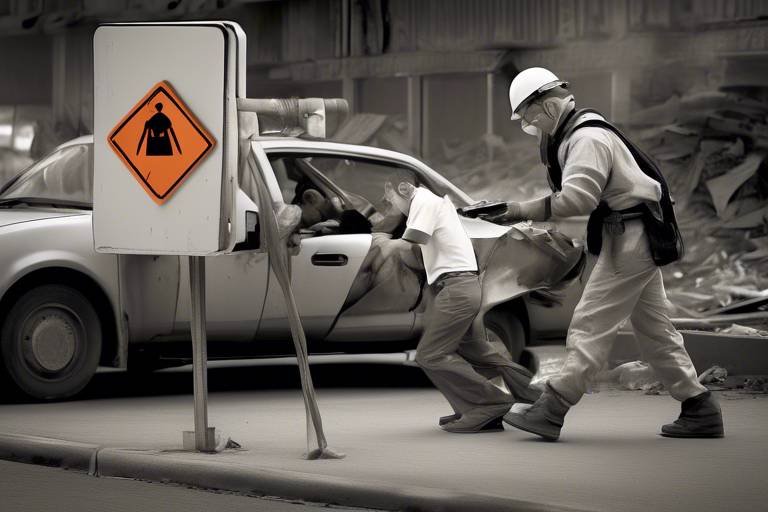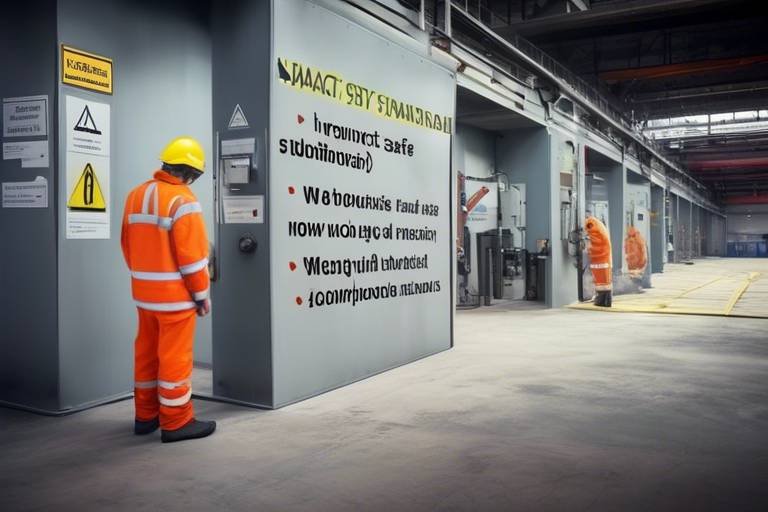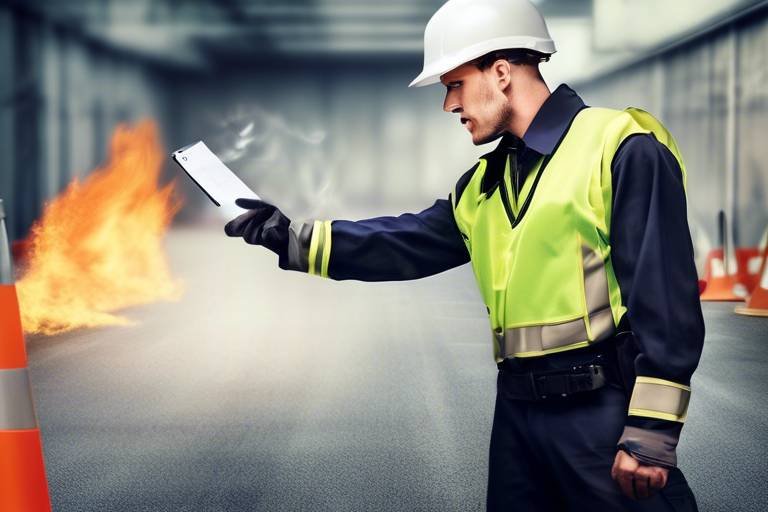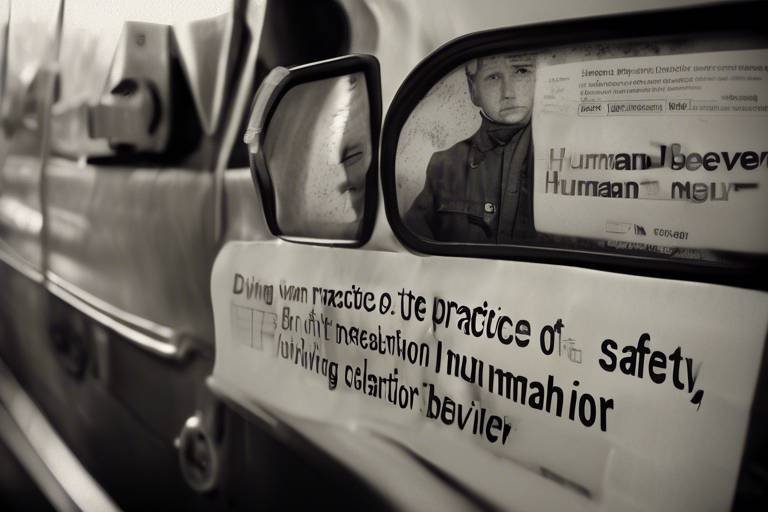Observing Human Behavior: A Gateway to Advanced Safety Tactics
In a world where safety is paramount, understanding human behavior becomes the cornerstone of effective safety measures. Imagine walking through a bustling workplace or a crowded public space; every interaction, every choice made by individuals can either enhance safety or lead to unforeseen risks. This article explores the significance of observing human behavior, illustrating how psychological insights and practical applications can transform safety protocols. By delving into the intricacies of human actions, we can uncover the patterns that often lead to accidents and develop strategies to prevent them.
Why is human behavior such a critical component of safety? The answer lies in the fact that most accidents stem from human actions. Understanding how people think, feel, and react in various situations is essential for creating effective safety protocols. For instance, consider a construction site where workers are constantly exposed to hazards. If they are not aware of their surroundings or fail to follow safety guidelines, the likelihood of accidents increases dramatically. Therefore, addressing psychological factors in safety training is not just beneficial; it's necessary.
Incorporating behavioral insights into safety training can lead to significant improvements in compliance and risk management. When individuals understand the reasons behind safety protocols and how their behavior influences outcomes, they are more likely to engage in safe practices. This psychological approach can be likened to planting a seed; with the right nurturing, it can grow into a robust safety culture that benefits everyone.
What drives individuals to take risks, even when they know the potential consequences? This question is at the heart of understanding risk behavior. Psychological factors such as cognitive biases, emotions, and social influences play a pivotal role in decision-making. For example, the illusion of invulnerability can lead individuals to underestimate risks, while peer pressure can encourage unsafe practices. By unraveling these motivations, safety professionals can design targeted interventions that effectively reduce risky behaviors.
Have you ever wondered how economics can influence safety? Behavioral economics sheds light on the decision-making processes that impact safety outcomes. It combines insights from psychology and economics to understand how people make choices. For instance, by framing safety messages in a way that highlights potential losses rather than gains, individuals may be more inclined to adopt safer behaviors. This approach can be likened to a gentle nudge, guiding individuals toward safer choices without imposing strict regulations.
Implementing incentives can significantly impact safety behavior. Organizations that offer rewards for safe practices often see a marked improvement in compliance. These incentives can take various forms, such as:
- Monetary bonuses for accident-free months
- Recognition programs for employees who demonstrate exemplary safety practices
- Additional training opportunities as rewards for safe behavior
By fostering a culture of recognition and reward, organizations can motivate individuals to prioritize safety in their daily routines.
The way safety messages are framed can alter perceptions and behaviors. For example, instead of simply stating, "Wear your helmet," a more impactful message could be, "Wearing your helmet can save your life." This subtle shift in language emphasizes the positive outcome of safe behavior. Effective communication is vital in enhancing compliance and engagement, making it essential for organizations to invest in training their leaders on how to convey safety messages effectively.
Observation is a key tool in identifying unsafe behaviors. By systematically observing and analyzing human actions, organizations can pinpoint areas for improvement in their safety protocols. This proactive approach allows for adjustments before accidents occur, ultimately saving lives. Techniques such as behavioral audits and peer observations can provide valuable insights into how safety measures are being implemented on the ground.
Effective training programs should incorporate behavioral insights to be truly impactful. By designing training that addresses human behavior, organizations can promote a culture of safety that resonates with employees. This approach not only enhances compliance but also fosters a sense of ownership over safety practices.
Simulation and role-playing are powerful tools in training. Imagine a scenario where employees can practice safe behaviors in a controlled environment, allowing them to experience the consequences of their actions without real-world risks. These techniques can significantly enhance learning and retention, making safety training not just informative but also engaging.
Feedback is essential for ongoing safety improvement. Organizations that actively gather and utilize feedback can adapt their safety strategies based on observed behaviors. This continuous loop of learning and adaptation is akin to fine-tuning a musical instrument; with each adjustment, the organization becomes more harmonious in its approach to safety.
Q: Why is understanding human behavior important for safety?
A: Understanding human behavior is crucial because most accidents result from human actions. By addressing psychological factors and motivations, we can develop more effective safety protocols.
Q: How can incentives improve safety behavior?
A: Incentives can motivate individuals to prioritize safety by rewarding safe practices, fostering a culture of recognition and compliance.
Q: What role does observation play in safety?
A: Observation helps identify unsafe behaviors and areas for improvement in safety protocols, allowing organizations to make proactive adjustments.

The Importance of Human Behavior in Safety
Understanding human behavior is not just a nice-to-have in the realm of safety; it’s a critical component that can make or break safety protocols. Think about it: every day, we make choices that can either keep us safe or put us in harm's way. Whether it’s a construction worker deciding whether to wear a helmet or a driver choosing to text while driving, these decisions are deeply influenced by our behaviors and psychological state. When we dive into the psychology of these decisions, we uncover the root causes of risky behaviors, which allows us to craft more effective safety measures.
One of the most vital aspects of human behavior in safety is recognizing that it is often predictable. By understanding the patterns and triggers that lead to unsafe actions, we can develop strategies that not only educate but also motivate individuals to adhere to safety protocols. For instance, if we know that fatigue can lead to poor decision-making, we can implement policies that encourage regular breaks and promote a culture of rest. This understanding is not merely theoretical; it has real-world applications that can save lives and prevent accidents.
Moreover, addressing psychological factors in safety training is essential. People are more likely to follow safety guidelines when they feel a sense of ownership and responsibility. When safety training is designed with these psychological insights in mind, it can lead to a significant increase in compliance rates. For example, when employees are involved in the creation of safety protocols, they are more likely to take those protocols seriously. This participatory approach fosters a culture of safety where everyone feels accountable.
In summary, understanding human behavior is the gateway to enhancing safety measures. By delving into the psychological underpinnings of risk behavior and recognizing the predictable nature of these actions, we can create more effective safety protocols. This not only protects individuals but also fosters a culture of safety that permeates throughout organizations. So, the next time you think about safety, remember that it's not just about rules and regulations; it's about the people who follow them.

Psychological Insights into Risk Behavior
Understanding the psychological factors that drive individuals to engage in risky behavior is like peering into the mind of a daredevil. Why do some people take risks that seem irrational, while others play it safe? The answer lies in a complex interplay of emotions, cognitive biases, and social influences. By delving into these psychological insights, safety professionals can craft more effective interventions that not only address the behavior itself but also the underlying motivations.
At the heart of risk-taking behavior is the concept of perceived risk. This refers to an individual's assessment of the potential dangers associated with a specific action. Interestingly, people often underestimate the risks involved in familiar activities, leading to a false sense of security. For instance, driving a car or operating machinery may feel routine, but the dangers are ever-present. This disconnect can result in hazardous behaviors that compromise safety.
Moreover, cognitive biases play a significant role in how individuals perceive risk. For example, the optimism bias leads people to believe that they are less likely to experience negative outcomes compared to others. This can result in a disregard for safety protocols, as individuals may think, “It won’t happen to me.” On the flip side, the availability heuristic can cause people to overestimate the likelihood of rare events based on recent news or personal experiences. This can lead to an exaggerated fear of certain risks while underestimating more common dangers.
Social influences also shape our risk behavior. Peer pressure can be a powerful motivator, pushing individuals to engage in risky activities to gain acceptance or approval from others. This is especially prevalent in environments like workplaces, where the desire to fit in can overshadow personal safety. Understanding these social dynamics is crucial for developing targeted safety training that resonates with individuals on a personal level.
To effectively address these psychological aspects, safety professionals can implement strategies that cater to the human psyche. For example, utilizing behavioral nudges—subtle prompts that encourage safer choices—can be a game-changer. These nudges can be as simple as reminders, visual cues, or even gamification elements that make safety protocols more engaging and less of a chore.
| Psychological Factor | Description | Impact on Risk Behavior |
|---|---|---|
| Perceived Risk | How individuals assess the dangers of an action. | Can lead to underestimating risks in familiar situations. |
| Optimism Bias | Belief that negative outcomes are less likely to happen to oneself. | May result in ignoring safety protocols. |
| Availability Heuristic | Overestimating the likelihood of events based on recent experiences. | Can lead to disproportionate fear of rare risks. |
| Peer Pressure | Influence from others to conform to certain behaviors. | May encourage risky actions in social settings. |
In conclusion, recognizing the psychological factors behind risk behavior is essential for creating effective safety strategies. By understanding how individuals think and feel about risks, safety professionals can tailor their approaches to resonate with human behavior, ultimately fostering a culture of safety that is both proactive and engaging. As we continue to explore these insights, we pave the way for innovative solutions that not only prevent accidents but also empower individuals to make safer choices.
- What is perceived risk? Perceived risk refers to an individual's assessment of the potential dangers associated with a specific action. It often influences whether they choose to engage in risky behavior.
- How do cognitive biases affect safety? Cognitive biases, such as optimism bias and availability heuristic, can lead individuals to underestimate risks or overestimate the likelihood of rare events, impacting their safety decisions.
- What role does social influence play in risk behavior? Social influences, including peer pressure, can significantly impact an individual's willingness to engage in risky behaviors, often pushing them to prioritize acceptance over safety.
- How can behavioral nudges improve safety? Behavioral nudges are subtle prompts that encourage safer choices. By integrating these into safety protocols, organizations can make compliance easier and more engaging for individuals.

Behavioral Economics and Safety
Behavioral economics is a fascinating field that merges psychology with traditional economic theories, shedding light on how people make decisions—especially when it comes to safety. Think about it: have you ever noticed how some people seem to ignore safety protocols, while others adhere to them religiously? This disparity often boils down to the underlying psychological factors that influence risk-taking behaviors. By understanding these factors, safety professionals can craft interventions that not only resonate with individuals but also encourage safer choices in everyday situations.
At its core, behavioral economics challenges the notion that humans are always rational actors. Instead, it reveals that our decisions are often swayed by emotions, social pressures, and cognitive biases. For instance, the availability heuristic suggests that people judge the likelihood of an event based on how easily examples come to mind. If someone has recently heard about a workplace accident, they might become overly cautious, while another person who hasn't experienced or heard about such incidents may underestimate the risks involved. This discrepancy can lead to significant variations in safety practices across different teams or organizations.
To effectively apply behavioral economics to safety, professionals can implement strategies that leverage these insights. For example, creating a culture of safety can be achieved by highlighting positive safety behaviors through social proof. When individuals see their peers following safety protocols, they are more likely to emulate that behavior. Moreover, using nudges—subtle prompts that steer people toward safer choices—can also make a substantial difference. Consider the way signs are placed in high-risk areas, reminding workers to wear helmets or harnesses; these small reminders can have a big impact on compliance.
Another critical aspect of behavioral economics in safety is the use of framing. The way safety information is presented can significantly affect how it is received. For example, instead of simply stating that "90% of accidents occur due to unsafe behavior," a more effective message might be, "Join the 10% of workers who prioritize safety and stay accident-free." This positive framing can motivate individuals to change their behaviors, aligning their actions with safety objectives.
Incorporating these behavioral economics principles into safety protocols not only enhances compliance but also fosters a deeper understanding of the importance of safety measures. Organizations that recognize the psychological underpinnings of their employees' decisions can create tailored interventions that resonate on a personal level, ultimately leading to a safer workplace. With each step toward understanding human behavior, we inch closer to a culture where safety is not just a requirement but a shared value among all employees.
In summary, behavioral economics offers invaluable insights into how we can improve safety protocols. By recognizing the psychological factors that drive decision-making, implementing nudges, and framing safety messages effectively, organizations can cultivate an environment where safety becomes second nature. It's about creating a mindset where everyone feels responsible for their safety and the safety of those around them.

Incentives for Safer Behavior
When it comes to promoting safety in any environment, the role of incentives cannot be overstated. Think of incentives as the fuel that drives individuals toward safer behaviors. Just like a car needs gas to run, organizations need well-structured incentives to encourage their employees to prioritize safety. But how do we create these incentives? It’s all about understanding what motivates people and crafting rewards that resonate with them.
One effective approach is the implementation of a reward system that recognizes safe practices and behaviors. For instance, organizations can offer monetary rewards, such as bonuses or gift cards, to employees who consistently follow safety protocols. This not only boosts morale but also instills a sense of accountability among workers. Imagine walking into a workplace where everyone is vying for the 'Safety Star of the Month' award. The friendly competition can transform the safety culture into one that is proactive rather than reactive.
Additionally, non-monetary incentives can also play a crucial role. Acknowledgment in front of peers, certificates of appreciation, or even a simple thank-you note can go a long way in making employees feel valued. When people feel appreciated, they are more likely to continue engaging in safe practices. Consider this: when was the last time you felt motivated to go the extra mile simply because someone recognized your efforts? It’s a powerful motivator!
Moreover, it’s essential to tailor incentives to meet the diverse needs of the workforce. Some employees may respond better to public recognition, while others might prefer private accolades. Understanding these differences can help organizations design a more effective incentive program. Here’s a quick look at some popular incentive structures:
| Incentive Type | Description | Example |
|---|---|---|
| Monetary Rewards | Financial bonuses or gift cards | $100 gift card for safe practices |
| Public Recognition | Acknowledgment during meetings or events | “Safety Star of the Month” award |
| Training Opportunities | Access to advanced training or workshops | Free safety training course |
| Team Incentives | Group rewards for collective safety achievements | Team outing for zero accidents in a month |
In addition to these structures, it’s crucial to maintain an open line of communication between management and employees regarding safety practices. Regularly soliciting feedback on the incentive programs can help organizations adjust their strategies to better meet the needs and expectations of their workforce. After all, a successful incentive program is not static; it evolves based on what works and what doesn’t.
In summary, the implementation of effective incentives for safer behavior is a multifaceted approach that requires understanding, creativity, and constant adaptation. By recognizing and rewarding safe practices, organizations can foster a culture of safety that benefits everyone. So, ask yourself: what incentives can you implement today to encourage safer behaviors in your environment?
- What are the most effective types of incentives for promoting safety? Monetary rewards, public recognition, and team incentives are some of the most effective types.
- How can I tailor incentives to my workforce? Consider conducting surveys or feedback sessions to understand what motivates your employees.
- Can non-monetary incentives be as effective as monetary ones? Yes, non-monetary incentives, like recognition and training opportunities, can also significantly motivate employees.
- How often should I review my incentive programs? Regular reviews, at least annually, are recommended to ensure the program remains effective and relevant.

Framing Safety Messages
When it comes to safety, the way we frame our messages can be the difference between compliance and negligence. Imagine walking into a construction site where the safety signs are worded in a way that sounds more like a suggestion than a rule. Would you take them seriously? Probably not. This is why framing is so crucial in safety communication. It’s not just about what you say, but how you say it. The right framing can grab attention, evoke emotions, and inspire action.
One effective technique is to use positive framing. Instead of saying, "Don’t forget your hard hat," you might say, "Wearing your hard hat keeps you safe!" This subtle shift not only highlights the importance of the action but also creates a sense of empowerment. People are more likely to engage in safe behaviors when they feel they are making a choice for their own well-being, rather than being told what to do.
Additionally, incorporating relatable scenarios in safety messages can make the information more impactful. For example, instead of a generic warning about slips and falls, consider sharing a brief story: "Last week, John slipped on a wet floor because he wasn’t wearing his non-slip shoes. Let’s keep John’s story from repeating!" This kind of narrative not only illustrates the potential consequences of unsafe behaviors but also personalizes the message, making it more relatable and memorable.
Furthermore, visual elements play a significant role in framing safety messages. A well-designed poster with vibrant colors and clear graphics can draw attention and convey information quickly. According to research, people process visual information faster than text. Thus, combining strong visuals with concise, impactful wording can enhance understanding and retention. For instance, a simple infographic that outlines the steps for proper lifting techniques can be much more effective than a lengthy paragraph of text.
To illustrate the impact of framing in safety messages, consider the following table that compares different framing strategies:
| Framing Strategy | Example Message | Potential Impact |
|---|---|---|
| Negative Framing | “Don’t forget to wear your safety goggles.” | May lead to resistance or disregard. |
| Positive Framing | “Wearing safety goggles protects your vision!” | Encourages proactive behavior. |
| Storytelling | “Remember when Sarah avoided injury by using her harness?” | Creates relatability and urgency. |
| Visual Elements | Infographic on safe lifting techniques. | Enhances understanding and retention. |
In summary, effectively framing safety messages isn’t just about delivering information; it’s about crafting a narrative that resonates with individuals. By using positive language, relatable stories, and compelling visuals, organizations can foster a culture of safety where employees feel motivated to prioritize their well-being and that of their colleagues. After all, safety should never feel like a chore; it should feel like a shared responsibility that everyone is eager to uphold.
- Why is the framing of safety messages important? Framing can significantly influence how individuals perceive and respond to safety information, impacting their likelihood of compliance.
- What are some effective strategies for framing safety messages? Positive framing, storytelling, and the use of visuals are all effective strategies that can enhance the impact of safety communications.
- How can organizations measure the effectiveness of their safety messaging? Organizations can gather feedback through surveys, observe changes in behavior, and analyze incident reports to assess the impact of their safety messages.

The Role of Observation in Safety Protocols
Observation plays a crucial role in enhancing safety protocols across various industries. By closely monitoring behaviors and environments, safety professionals can identify potential hazards before they lead to accidents. Imagine walking into a busy construction site; the chaos of machinery, workers hustling about, and the constant noise can easily mask unsafe practices. However, through vigilant observation, one can spot a worker not wearing a hard hat or someone operating machinery without proper training. These observations are not just about catching wrongdoings; they are about creating a safer work environment.
One of the key methods of effective observation is through the use of structured techniques. For example, employing checklists can help observers focus on specific behaviors or conditions that may pose risks. A checklist might include items such as:
- Proper use of personal protective equipment (PPE)
- Compliance with safety signage
- Correct operation of machinery
- Awareness of surroundings
These items serve as a guide, ensuring that nothing is overlooked during the observation process. Furthermore, observation should not be a one-time event; it needs to be ongoing and integrated into the daily routine of safety management. Regular observation helps in recognizing patterns of behavior that could indicate deeper issues, such as a lack of training or complacency among workers.
Additionally, technology has transformed the way we observe safety practices. With tools like video surveillance and wearable technology, organizations can monitor behaviors in real-time, analyze data, and make informed decisions to enhance safety protocols. For instance, a company might use footage from cameras to review incidents and identify whether a lack of adherence to safety protocols contributed to an accident. This not only aids in understanding what went wrong but also helps in developing targeted training programs to address specific issues.
Moreover, involving employees in the observation process can significantly increase safety awareness. When workers are empowered to observe and report unsafe behaviors, it fosters a culture of safety where everyone feels responsible for maintaining a safe working environment. This collaborative approach can lead to more comprehensive safety protocols, as insights from various team members can highlight areas that might have been overlooked by management.
In summary, observation is not just a passive activity; it is an active and dynamic part of safety protocols. By leveraging structured techniques, technology, and employee involvement, organizations can create a robust safety culture that not only identifies risks but also proactively addresses them. This ultimately leads to a safer workplace, where the focus is on prevention rather than reaction.

Training Programs Focused on Behavior
When it comes to enhancing safety in any environment, training programs that focus on human behavior are absolutely essential. These programs go beyond traditional safety training methods by addressing the psychological and behavioral aspects that influence how individuals respond to safety protocols. By recognizing that behavior is often a reflection of underlying beliefs and motivations, organizations can create training that truly resonates with participants. This approach not only improves compliance but also fosters a culture of safety where everyone feels responsible for their own and others’ well-being.
One of the most effective ways to engage participants is through interactive training techniques. For instance, incorporating simulation and role-playing exercises allows individuals to practice safe behaviors in a controlled environment. Imagine a construction site where workers can simulate a scenario involving heavy machinery without the actual risk. This hands-on experience not only reinforces the importance of safety protocols but also allows trainees to make mistakes and learn from them in a safe setting. By actively participating in these scenarios, individuals are more likely to internalize safe practices and apply them in real-life situations.
Furthermore, a well-rounded training program should also include a strong component of feedback and continuous improvement. After training sessions, gathering feedback from participants can provide invaluable insights into what works and what doesn’t. Organizations can use this feedback to adapt their training methods, making them more relevant and effective over time. For example, if trainees express confusion about certain safety protocols, the program can be adjusted to clarify these points, ensuring that everyone is on the same page. This cycle of feedback and adaptation not only improves the training experience but also enhances overall safety outcomes.
Additionally, it’s crucial to understand the different learning styles of participants. Not everyone absorbs information the same way, which is why incorporating a variety of teaching methods—such as visual aids, hands-on activities, and group discussions—can be beneficial. By catering to different learning preferences, trainers can ensure that all participants grasp the essential safety concepts being taught. This inclusive approach makes the training more engaging and effective, leading to a workforce that is better prepared to handle safety challenges.
To illustrate how these components come together, consider the following table, which outlines the key elements of an effective behavior-focused training program:
| Training Element | Description | Benefits |
|---|---|---|
| Interactive Techniques | Use of simulations and role-playing to practice safety scenarios. | Enhances engagement and retention of safety protocols. |
| Feedback Mechanisms | Gathering participant feedback post-training. | Allows for continuous improvement and adaptation of training materials. |
| Diverse Learning Styles | Incorporating various teaching methods to cater to all participants. | Improves understanding and application of safety practices. |
In conclusion, are vital for fostering a safety-conscious culture within organizations. By utilizing interactive techniques, encouraging continuous feedback, and accommodating different learning styles, organizations can significantly enhance the effectiveness of their training efforts. This comprehensive approach not only prepares individuals to follow safety protocols but also empowers them to take an active role in promoting safety in their workplaces.
- What is the main goal of behavior-focused training programs?
The main goal is to enhance safety by addressing the psychological and behavioral factors that influence how individuals respond to safety protocols. - How can simulation and role-playing improve safety training?
These techniques provide a hands-on experience, allowing participants to practice safe behaviors in a controlled environment, which reinforces learning. - Why is feedback important in training programs?
Feedback helps organizations adapt their training methods based on participant experiences, ensuring that the training remains relevant and effective. - How can diverse learning styles be accommodated in training?
By incorporating various teaching methods such as visual aids, hands-on activities, and discussions, trainers can cater to the different ways individuals learn.

Simulation and Role-Playing Techniques
When it comes to training individuals in safety protocols, simulation and role-playing techniques stand out as two of the most effective methods. These techniques allow participants to immerse themselves in realistic scenarios, providing a unique opportunity to practice responses to potential hazards. Imagine stepping into a virtual world where you can make mistakes without real-world consequences—this is the essence of simulation training!
Simulation provides a controlled environment where trainees can engage with various scenarios that mimic actual workplace conditions. For instance, consider a construction site where workers must navigate through various safety risks. By using simulation, they can experience situations like equipment malfunctions or unexpected weather changes, all while learning to respond appropriately. This hands-on approach not only enhances their skills but also builds confidence in their ability to handle emergencies.
Similarly, role-playing allows participants to assume different roles within a scenario, fostering a deeper understanding of team dynamics and communication. When trainees engage in role-playing exercises, they can explore how their actions affect others and learn the importance of collaboration in maintaining safety. For example, one person might take on the role of a safety officer, while another acts as a worker facing a safety challenge. This dynamic interaction encourages critical thinking and problem-solving skills.
Moreover, these techniques can be tailored to fit specific organizational needs. By customizing scenarios to reflect the unique risks associated with a particular industry, organizations can ensure that their training is relevant and impactful. For instance, a healthcare facility might simulate a patient emergency, allowing staff to practice their response in a safe yet realistic setting.
To further enhance the effectiveness of simulation and role-playing, it’s essential to incorporate debriefing sessions after each exercise. These sessions provide an opportunity for participants to reflect on their experiences, discuss what worked well, and identify areas for improvement. This feedback loop is crucial for reinforcing learning and ensuring that safety protocols are understood and retained.
In conclusion, simulation and role-playing techniques are invaluable tools in the realm of safety training. They not only provide a safe space for individuals to practice and refine their skills but also foster a culture of safety that extends beyond the training room. By investing in these innovative training methods, organizations can significantly enhance their safety outcomes and empower their workforce to act decisively in the face of danger.
- What is the main benefit of simulation training? Simulation training allows participants to practice real-life scenarios without the risk of actual harm, enhancing their preparedness for emergencies.
- How does role-playing improve safety training? Role-playing encourages teamwork and communication, helping participants understand their roles in safety protocols and how their actions impact others.
- Can simulation be customized for specific industries? Yes, simulation scenarios can be tailored to reflect the unique risks and challenges of different industries, making the training more relevant and effective.
- What is the importance of debriefing after training exercises? Debriefing sessions allow participants to reflect on their experiences, discuss successes and challenges, and reinforce learning, which is essential for continuous improvement.

Continuous Improvement through Feedback
In the realm of safety, continuous improvement is not just a buzzword; it's a vital process that ensures organizations evolve and adapt to new challenges. Feedback serves as the lifeblood of this process, allowing teams to identify what works, what doesn’t, and how to refine their safety protocols. Think of feedback as a GPS system for safety practices—it helps you navigate through the twists and turns of human behavior and organizational needs.
When we talk about feedback, it’s essential to understand that it comes in various forms. It can be formal or informal, solicited or unsolicited. The key is to create an environment where feedback is valued and encouraged. This means fostering a culture where employees feel safe to share their observations and experiences without fear of retribution. When people know their voices matter, they are more likely to provide insights that can lead to significant safety improvements.
One effective way to gather feedback is through regular safety meetings or debriefing sessions. These gatherings not only allow for open discussions but also provide a platform for sharing real-life experiences related to safety practices. During these meetings, organizations can utilize structured feedback forms or surveys that encourage employees to share their thoughts on existing safety measures. For instance, questions like:
- What safety measures do you find most effective?
- Have you encountered any challenges with current protocols?
- What suggestions do you have for improvement?
These questions can spark meaningful conversations and lead to actionable insights. Additionally, organizations can implement anonymous feedback tools, allowing employees to express concerns without the fear of being identified. This can be particularly beneficial in industries where speaking up might feel intimidating.
Moreover, it's not just about collecting feedback; it’s about acting on it. Organizations should have a clear process in place for reviewing feedback and implementing changes. Setting up a feedback loop ensures that employees see their input valued and acted upon. This reinforces the idea that safety is a shared responsibility and that everyone plays a role in enhancing it.
Another crucial aspect of continuous improvement through feedback is the use of data analysis. By systematically analyzing incident reports, near-miss occurrences, and employee feedback, organizations can identify trends and patterns that may not be immediately obvious. For example, if multiple employees report near-misses in a specific area, it may indicate a need for additional training or a review of safety protocols in that location.
Furthermore, organizations can leverage technology to enhance feedback collection and analysis. Tools like mobile apps or online platforms can streamline the process, making it easier for employees to report issues or suggest improvements in real time. This not only increases participation but also allows for quicker response times to safety concerns.
In summary, is a dynamic process that relies on open communication, data-driven decisions, and a culture of safety. By actively seeking and responding to feedback, organizations can create a safer work environment that not only protects employees but also enhances overall operational efficiency. Remember, safety isn’t a destination; it’s a journey that requires constant vigilance and adaptation.
- Why is feedback important for safety improvement? Feedback provides insights into the effectiveness of safety measures and highlights areas for improvement.
- How can organizations encourage feedback from employees? By fostering a culture of openness and using anonymous tools for reporting, organizations can encourage more employees to share their thoughts.
- What are some effective methods for collecting feedback? Regular safety meetings, surveys, and anonymous reporting tools are excellent methods for gathering feedback.
- How should organizations respond to feedback? Organizations should review feedback systematically and implement changes based on the insights gathered to show employees that their input is valued.
Frequently Asked Questions
- Why is understanding human behavior important for safety?
Understanding human behavior is crucial because it helps identify the underlying psychological factors that influence safety outcomes. By recognizing how people think and act in various situations, safety protocols can be tailored to address these behaviors effectively, ultimately reducing the risk of accidents and enhancing overall safety.
- What psychological factors drive individuals to take risks?
Several psychological factors can drive individuals to engage in risky behaviors, including overconfidence, peer pressure, and a lack of awareness about potential dangers. By understanding these motivations, safety professionals can create targeted interventions that encourage safer choices and reduce the likelihood of accidents.
- How can behavioral economics be applied to safety?
Behavioral economics can be applied to safety by analyzing how people make decisions and what influences those choices. By leveraging economic principles, organizations can design incentives and nudges that promote safer behaviors, making it easier for individuals to choose safety over risk.
- What types of incentives are effective in promoting safer behavior?
Effective incentives can include financial rewards, recognition programs, and safety competitions. By providing tangible benefits for safe practices, organizations can motivate employees to prioritize safety in their daily routines, thus fostering a culture of safety.
- How can the framing of safety messages impact behavior?
The way safety messages are framed can significantly influence how they are perceived and acted upon. For example, emphasizing the positive outcomes of safe behavior rather than the negative consequences of unsafe actions can lead to greater compliance and engagement from individuals.
- What role does observation play in improving safety protocols?
Observation is a key tool in identifying unsafe behaviors and practices. By systematically observing individuals in various settings, safety professionals can gather valuable data that informs the development of more effective safety protocols and interventions.
- How can training programs incorporate behavioral insights?
Training programs can incorporate behavioral insights by focusing on real-life scenarios and the psychological factors that influence behavior. By using interactive methods such as simulations and role-playing, trainers can help participants understand and practice safe behaviors in a controlled environment.
- What are the benefits of using simulation and role-playing in training?
Simulation and role-playing allow individuals to experience realistic scenarios and practice their responses without the risk of real-world consequences. This hands-on approach enhances learning retention and builds confidence in applying safety measures in actual situations.
- Why is feedback important for continuous safety improvement?
Feedback is essential for continuous improvement because it provides insights into what is working and what needs adjustment. By regularly gathering and analyzing feedback, organizations can adapt their safety strategies to better align with observed behaviors and emerging risks.



















